The penultimate post in this series, taking you on a whirlwind tour of my wader birding and twitches. Maybe not the high quality of some earlier posts, but hopefully some interesting back stories.
100 Asian Dowitcher Limnodromus semipalmatus
A rare wader of the east-asian flyway. I’ve seen Asian Dowitcher a couple of times, with the first on a mega-wader day with Steve in the Gulf of Thailand. This was one of the few species seen in that 2014 trip that I missed in 2010. Subsequently I found 4 at Cape Nanhui near Shanghai when I was over there as a visiting lecturer for a fortnight. On Saturday I went birding, as I usually do when I’m away from home over the weekend. My main target was Reed Parrotbill, which we found early on, and then spent the rest of the day looking for waders and bitterns as well as a few passerine migrants in the small “micro-forest” that dot the coast. Blog post here, but sh*t photo BTW!
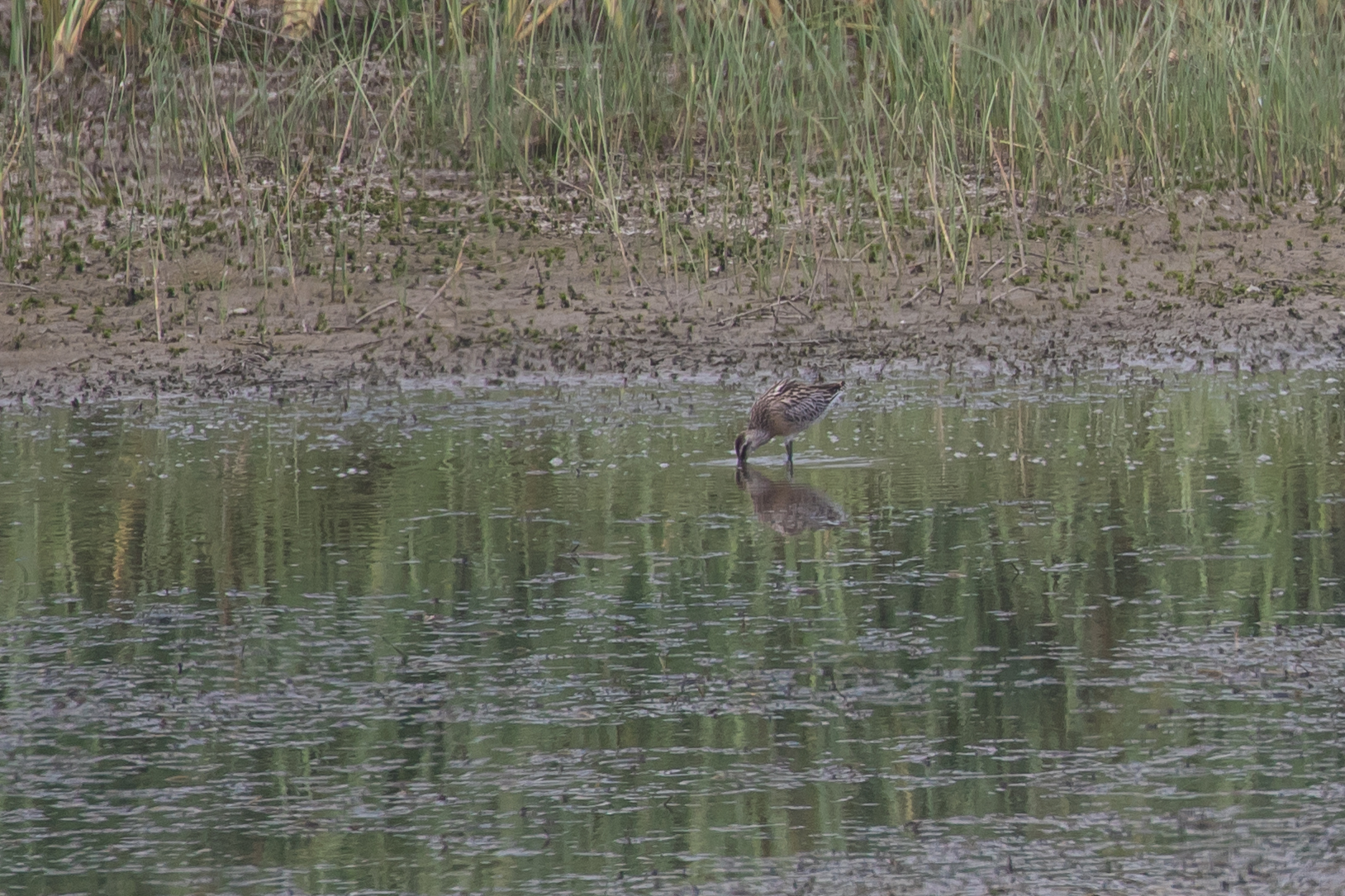
101 Long-billed Dowitcher Limnodromus scolopaceus
I ticked off Long-billed Dowitcher on my Santa Barbara trip in March 2011. About a dozen dowitchers were feeding in Deveraux Slough. I have to admit that I would struggle to tell them apart from Short-billed, but I was assured by a local that they were LBD and that Short-billed would be much less common in this spot at this time of year. A few days later I saw dozens more at Salton Sea, slightly reassured that SBD are seen inland much less commonly than Long-billed. At one point I had also ticked Short-billed but I have unticked it on the basis that I can’t be sure that birds I saw (and photographed) in Texas in 2000 are not Long-billed. In fact when I examine the film scans in the light of 20 more years’ experience, 3 field guides and the web, I am still not sure but lean to Long-billed on the basis of the white-fringed scapulars (not orange-fringed). The picture is from that 2000 film scan, and I’d be delighted to be proven wrong since it would give me back a tick!

102 Eurasian Woodcock Scolopax rusticola
Woodcocks rank among the best waders; cryptic, enigmatic, and filling a unique ecological niche amongst waders by living and breeding in woodland and forests, not mudflats and wetlands. It goes some way to explaining, but makes no less sore, the fact that I have no decent photos. An added bonus is their funky name that over New Year in 2002/3 with Steve at Bremridge, gave rise to the tongue-twisting conundrum – “how much cock would a woodcock suck if a woodcock could suck cock?” Answers on the back of a postcard, please.
Near Oxford I used see Woodcock roding at dusk whenever I went in the spring to Snelsmore Common, just over the border in Berks. This lovely site, impacted and reduced by the controversial Newbury Bypass in the 1990s fortunately still retains breeding Woodcock, Nightjar and Tree Pipit, all rare or even extinct in Oxfordshire. My best views of Woodcock were in Scotland on our “Grouse and Raptor” trip in 2002 when Steve Young, Duncan Orr-Ewing and I found one on the deck by the side of the road in the Findhorn valley, shortly after I had ticked off a superb Golden Eagle. The picture below shows my digiscoped photo of a bird at Titchwell Marsh that was roosting just outside the visitor centre in Feb 2004. It was so close that I could not get back far enough to see the whole bird so squeezed off this record shot!
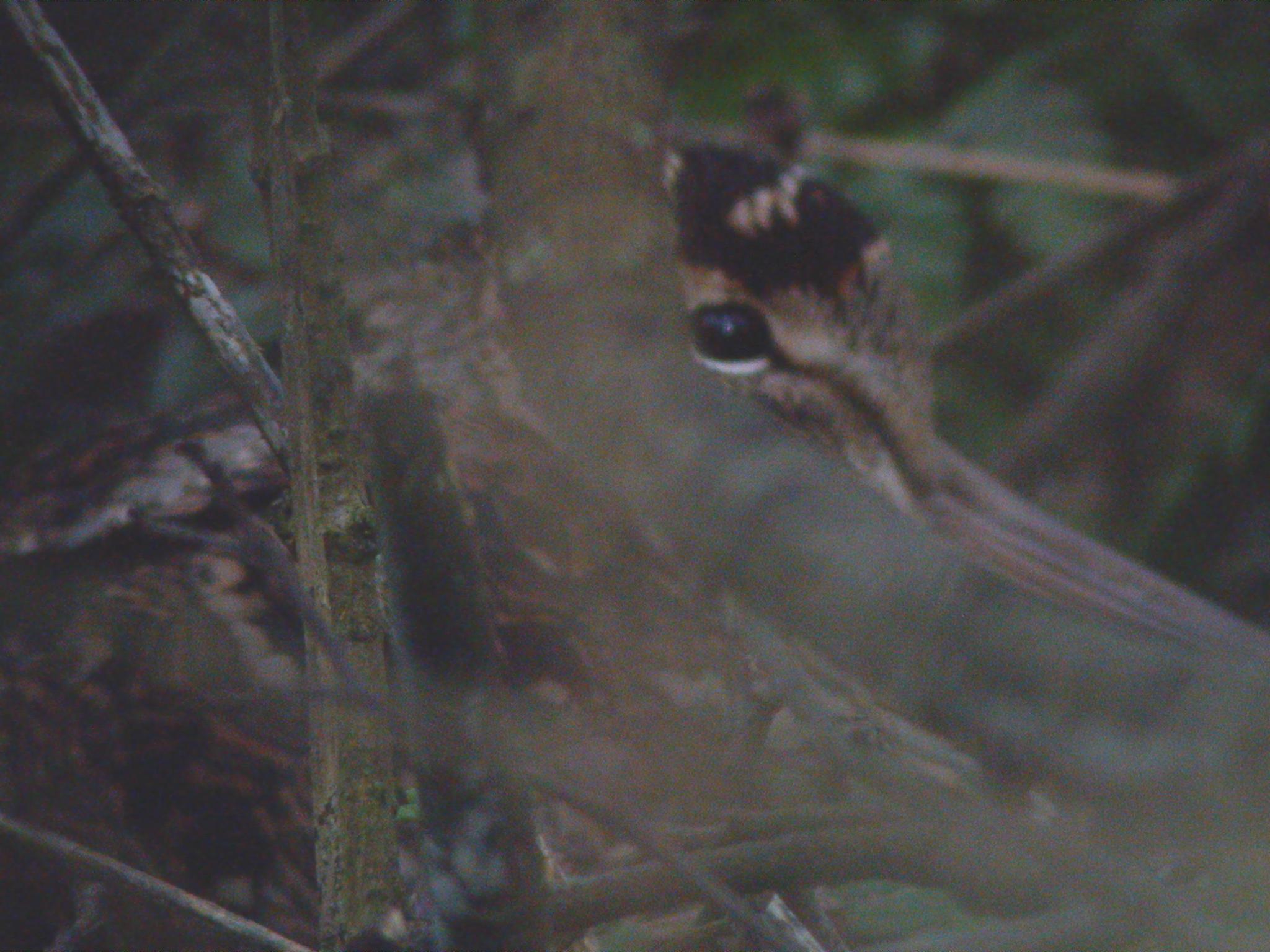
103 New Guinea Woodcock Scolopax rosenbergii
In 2018 I managed a 3 week trip to West Papua, home to some of the most amazing and unique avifauna on the planet. Originally I was only going to go for just over two weeks and join fellow travellers Steve Young and Jon Porter in Nimbokrang after they had birded the Snow Mountains for for 4 days. In the end the pressure of being forever gripped off by them told, and with a bit of tweaking of both work and domestic priorties I was able to join them for the first part of the trip to the roof of Australasia. We spent 4 nights camped in a hastily custom-constructed tent at 3500m near Lake Habbema above the Baliem Valley, a spot so remote it was only “discovered” by westerners in the 20th century. The full tale of that trip is in my blog posts from 2018, with the Habbema leg here. The reason for mentioning that here is that one of our top targets was New Guinea Woodcock. It’s roding flight call is one of the more bizarre songs from the bird world.
This bird is fairly widespread in New Guinea highlands, but the highlands are mostly inaccessible and the bird cryptic and hard to see, so it is not reported from many sites. The top of the Ibele Trail at Lake Habbema is just about the most reliable site on the planet. After dipping one morning when we came back in the evening; we were getting very cold, very hungry and losing hope when from the jaws of defeat we snatched victory with superb views of a couple of very close flights past our vantage point. Photography was secondary to seeing the bird well, but there might have been the chance of a cracking photo had our guide not removed the torch a bit early. As it was, we had great memories but nothing on the CompactFlash.
104 Bukidnon Woodcock Scolopax bukidnonensis
Another woodcock of the far east highlands, this time the Philippines. Bukidnon Woodcock was only discovered in 1993 by a Birdquest tour group on Mt Kitanglad. In 2010 I was in the Philippines with Steve on a Birdtour Asia custom tour, taking in Mindanao, Palawan and a couple of sites on Luzon (trip report here). Our number one target and main reason for being on Mt Kitanglad was to see Philippine Monkey-eating Eagle, one of the world’s rarest and most impressive raptors. But Bukidnon Woodcock was one of several other secondary targets. Each evening around dusk we would hear the high-pitched twitter and grunting and assemble of the lawn in front of our camp for a fly-past. I tried to take a photo with my 30D’s built-in flash. Thta’s it in the bottom left of frame, slight eyeshine reflecting back (lol)…

105 Jack Snipe Lymnocryptes minimus
When I first started birding proper, one of the sites I visited most was Otmoor. In the days before large chunks of farmland were purchased by the RSPB and returned to their original wetland and meadow state, birders would walk across the MoD firing range (making sure that the red flags were not flying!) about a kilometre to The Pill, a small boggy area favoured by Snipe and occasionally Hen Harrier and Short-eared Owl. Back in the day I didn’t keep notes often, but just before Christmas 1999, 23rd December I had a particularly good afternoon/evening and I’ve just discovered that I took the time to I write it up.
I knocked off work at lunch time and decided to take advantage of a fine afternoon with a stroll on Otmoor. I arrived at about 2pm, and finally left at about 4.30 as it became quite dark. Although the total number of birds I encountered was actually quite small, these were some of my best ever birding moments on Otmoor.
… I had already found Peregrine, Hen Harrier and Common Snipe by the time I was walking back to the car.
At about 4pm the sun had just gone down, but a dim light was still available. As I trudged back along the waterlogged Roman Road trying to pick a way through the almost completely flooded area 300m from the gate, a snipe sp. flushed silently from only a couple of metres in front of me. It wheeled around, and flew back north. I managed to get it in the bins nicely silhouetted for few brief seconds, and mentally noted the bill to have quite a thick base, and apparently shorter than normal for Common Snipe; about 1.5 head lengths. This was all the structural detail I made out at this point, but I tracked its flight – never more than a couple of metres above the ground – to where it landed, only about 30m away, next to the water-filled ditch and hedgerow which run north the length of the field.
Having noted where it landed, I retraced my steps and arrived where I thought it was, not having seen any further movement. I first checked the short grass on my side of the ditch and then walked to the edge and peered into the longer grass and hedge about 1.5m over the water but could not make anything out. It seemed quite possible that it had landed exactly where I was looking, but had snuck through the hedge and was now impossible to see. I tried to refocus my bins into the hedge but it was too close.
I resigned myself to its having disappeared and a potential tick with it and turned to leave. As I did so I got an incredible shock – with a rapid flutter of wings but no call, the bird flushed from almost under me and zipped off south, straight and low parallel with the hedge. With the naked eye I could see prominent gold streaks on its back, but unfortunately got nothing else of value on its plumage or structure. As I tried to get it in my bins the fact that they were close-focussed foiled my attempts to track it further and I did not relocate it.
In summary, although the bill length would be diagnostic, sadly I was not sure enough of my judgement on this aspect from the very brief views. However the behaviour is certainly consistent with Jack Snipe, and so as I walked away going through all the factors in my mind I realised that the likelihood was that this had indeed been Jack Snipe.
I have never seen another, but I am confident enough in this record to keep it. But would love to see one on the deck one day.
106 Latham’s Snipe Gallinago hardwickii
Latham’s are migrants, breeding in Japan and over-wintering in the Austral summer. My first came at one of the best local wetlands, Laratinga, about 30mins up the freeway from Adelaide in Mt Barker. This man-made wetland holds a bunch of special birds including more-or-less resident Freckled Duck, and when the water levels are just right in late summer it is perhaps the easiest place in the state and maybe even the country to see three species of crake (Australian spotted, Spotless and Baillon’s). It was probably my second or third trip there ever, in early 2013 when I met Bill O’Neill on the boardwalk and he pointed me to a reedbed where a Snipe was just peeking out. I’ve seen them there most summers, but never more than one or two. This photo was taken at Robe, about 2.5 hours south of Adelaide. A small and otherwise unremarkable boggy wetland on the outskirts of the town has for the last couple of years become a haven for Latham’s Snipe, holding several birds. There is even one ebird record from October 2018 (a month before my photo was taken) when a staggering 82 birds were reported!

107 Pin-tailed Snipe Gallinago stenura
Very hard to tell from Common Snipe, this photo was taken King’s Project, Thailand (shortly before I saw my first Spoon-billed Sandpiper!). At the time my guide suggested that there may be a diagnostic difference in the loral stripe – tapered in one and even in the other – but I can’t see it myself. The ID here is from the length of the bill, not quite as disproportionately outrageous as in Common. That still doesn’t unequivocally eliminate Swinhoe’s, but I am dude-ishly relying on range and balance of probabilities. A clear view of spread tail feathers seems to be the only way of distinguishing those two species if not in the hand.

108 Swinhoe’s Snipe Gallinago megala
I have no photo of Swinhoe’s, only a record from Bislig airfield (Mindanao, Philippines in Jan 2010). We were there hoping for Eastern Grass Owl (we did see one though distantly) and had had just come from seeing one of my favourite birds of the trip on the outskirts of PICOP, Silvery Kingfisher – what a stunner. As we paced about the airstrip waiting for dusk, and scanning for the Grass Owl and Philippine Duck, we flushed a couple of Swinhoe’s the grassy edges. They took off and flew high and far, the ID called by our leader, presumably on range and balance of probabilities, just like my Pin-tailed from Thailand several months later (see above).
109 Great Snipe Gallinago media
When I travelled to Poland in 2011 with Tom Bedford, we were both keen to see Great Snipe which lek at dusk on the boggy wetlands of the north east where low intensity agriculture has not yet fully disrupted nature like it has in most of Britain. Locations are generally a closely guarded secret because of the risk of disturbance, so we booked with a guide who took us to a site near the river-crossing village of Narew. We arrived as it was getting dark to realise there were several other tour groups there, all lined up about 150-200m distant from where the lek would take place. Unlike the rest of that trip which was relaxed and superb birding without the crowds of a British twitch (see Ruff in an earlier edition), this was a less-than-pleasant experience. At least the wind kept the mozzies –for which this site is notorious – at bay, but the crowd was a bit noisy and the distant, scope-only views underwhelming. Check out the video – Simon King would be proud!
110 Common Snipe Gallinago gallinago
Common Snipe in the UK is reasonably common (unlike some other birds with that forename!) and usually not difficult to see if you look in the right places. Over the years I saw many on Otmoor, almost always flushing high and handsome to some inaccessible part of the meadow, making their rasping flight call. My best views were usually at the Pinkhill Hide between the Thames and Farmoor Reservoir where there would often be birds roosting in the reeds and long grass, the hide allowing an approach that would not normally be possible. Although my aged Where to Watch Birds in Bedfordshire, Berkshire, Buckinghamshire, Hertfordshire and Oxfordshire (that’s a mouthful), says they could occasionally be in their hundreds on Port Meadow, I didn’t see them there very often, despite living on the edge of Port Meadow for four years and walking there regularly. So it’s slightly ironic that the only photos I could find were a series of poor digiscoped pictures taken in October 2007 on Port Meadow, nearly a decade after we had moved to Cumnor.

111 Wilson’s Snipe Gallinago delicata
I have already briefly described a couple of my best-ever US birding days. Wilson’s Snipe was one of the early ticks on my trip with the Sacramento Audubon club to the Sierra Valley (trip report). I’d arrived early before the meet and found some nice birds including Nashville Warbler, Yellow Warbler, Red-breasted Sapsucker, White-headed Woodpecker, Western Tanager and Sandhill Crane before rolling into Sierraville to meet the crew. Our first stop was a quick recce of the Sierraville aerodrome which produced Horned Lark and Wilson’s Snipe, both perched nicely fence-posts. Sadly the latter was rather distant so I didn’t even take a record shot.
112 South American Snipe Gallinago paraguaiae
In 2015 I was at the International Conference on Computer Vision in Santiago. I had already enjoyed a stellar day finding Diademed Sandpiper-plover in the High Andes (see earlier blog) and thought I would try my luck with this other desirable wader, South American Painted Snipe that is reported regularly by tour groups from one or two wetlands just north of the city. After the conference had ended for the day and my colleagues retired to bars and restaurants to network, I jumped in a rental vehicle and drove north in search of a swamp. Having parked up as far as a solid track would take me, I approached the Lampa Wetlands on foot and the ground got softer and softer. In the shallow water, clumps of reeds and grass provided decent hiding places for a variety of waders and ducks and I realised if I was to have any chance of getting a Painted Snipe I was going to get wet and muddy. I plodded around ankle deep in mud without finding one, but I did have a few nice birds include a Cinerous Harrier, Wren-like Rushbird and Many-coloured Rush-tyrant, and – the reason for this rambling paragraph – several South American Snipe which inevitably flushed high and far before I had seen any on the deck.
113 Terek Sandpiper Xenus cinereus
A bird with a funky up-turned bill that appears in SA regularly in small numbers. I saw my first in Dubai, just before I found another monotypic wader (see later) and noted my life bird without getting decent views or photos because I was concentrated on more important quarry (did I mention it was over 40 degrees in the shade, not that there was any). I was aware for a couple of years of a regular spot at the top of the Gulf of St Vincent, but never really fancied the 2km long walk through the samphire and across the mudflats in Port Clinton Conservation Park. However for a while one of the birds took up residence in the mangroves at the northern edge of the village, much more accessible and therefore twitchable. Here’s a pic from that trip, when I also added Greater Sand-plover to my SA and Australian lists.
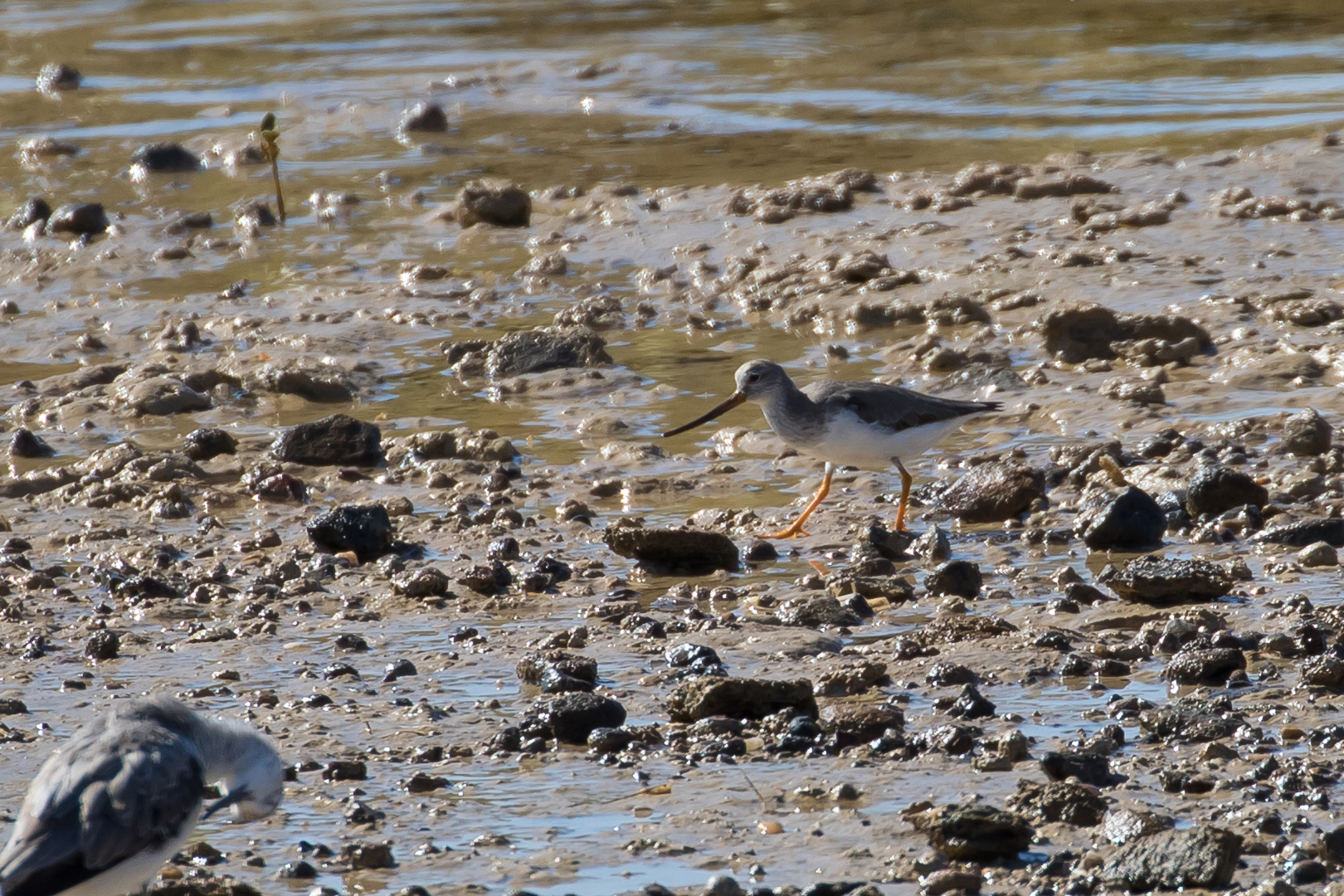
114 Wilson’s Phalarope Phalaropus tricolor
Wilson’s Phalarope is an American wader that is an occasional vagrant to Britain. I saw my first twitching a bird at Hillesden Pools in Buckinghamshire – a pretty extraordinary record for a landlocked county. Embarrassingly, Wilson’s was my first Phalarope, despite being the rarest of the trio in Britain. For such a pretty bird, these pools were not a very picturesque location, and even the best pics on the web are not great, distant and on an unattractive bank of mud. I don’t think I bothered digiscoping – it was a rushed job on a Saturday afternoon. My parents were visiting from Australia and I reckon I promised Nikki I could drive there, see the bird, and drive back in 2 hours in time to cook dinner!
My second was an altogether much better experience, even if the images were decidedly mediocre. This was on my wonderful day with the Sacramento Audubon group (see Wilson’s Snipe and Black-necked Stilt above). At the end of the afternoon we arrived at Marble Hot Springs Rd Wetlands where thousands of Yellow-headed Blackbirds were coming to roost, White-faced Ibis pottered about and a few Ruddy Duck swam the shallows. Wilson’s Phalarope was the star bird here.
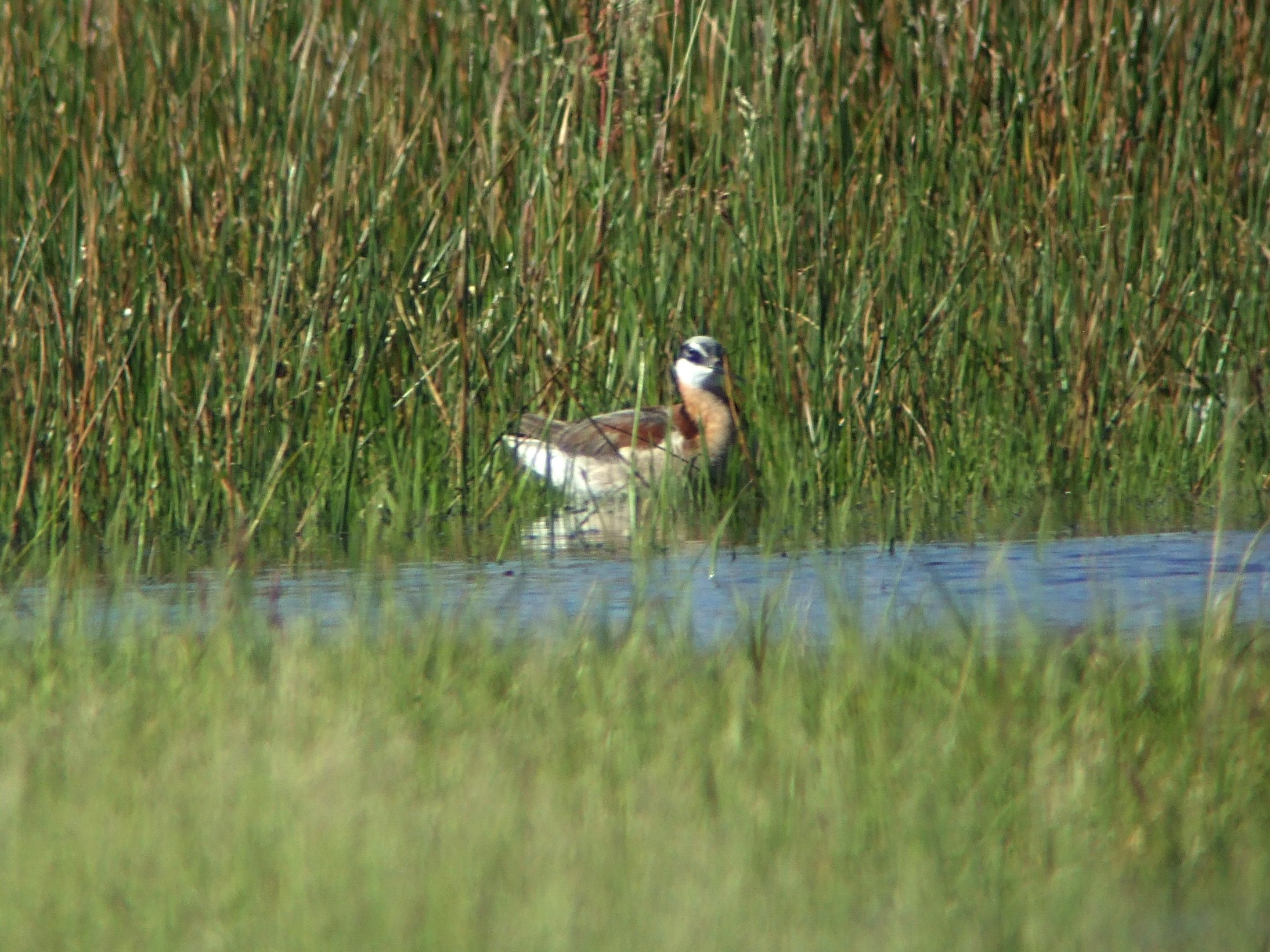
115 Red-necked Phalarope Phalaropus lobatus
Red-necked Phalarope was one of the last birds I twitched in Britain before moving to Australia. In late May I bombed over the border to Gloucestershire to Coombe Hill Nature Reserve because a pretty female (the females are smarter than the males) had taken up residence in the flooded fields and I had a chance to complete my set of three Phalaropes. After a soggy walk along the canal and a partially submerged boardwalk (I said the fields were flooded – it had been a very wet spring and was set to be the wettest summer I had in 24 years in Britain) I arrived in a wobbly hide. I captured some video that at least helps recreate the moment for me, though constant moving about of my fellow twitchers meant even with tripod, my video jumps and shakes, and my digiscoped images, as usual, leave something to be desired. Two years later, reunited at Bangkok airport for some far east birding, Steve and I had a nice flock of a dozen or so at Pak Thale in 2014 (but somewhat overshadowed by our Spoonie)
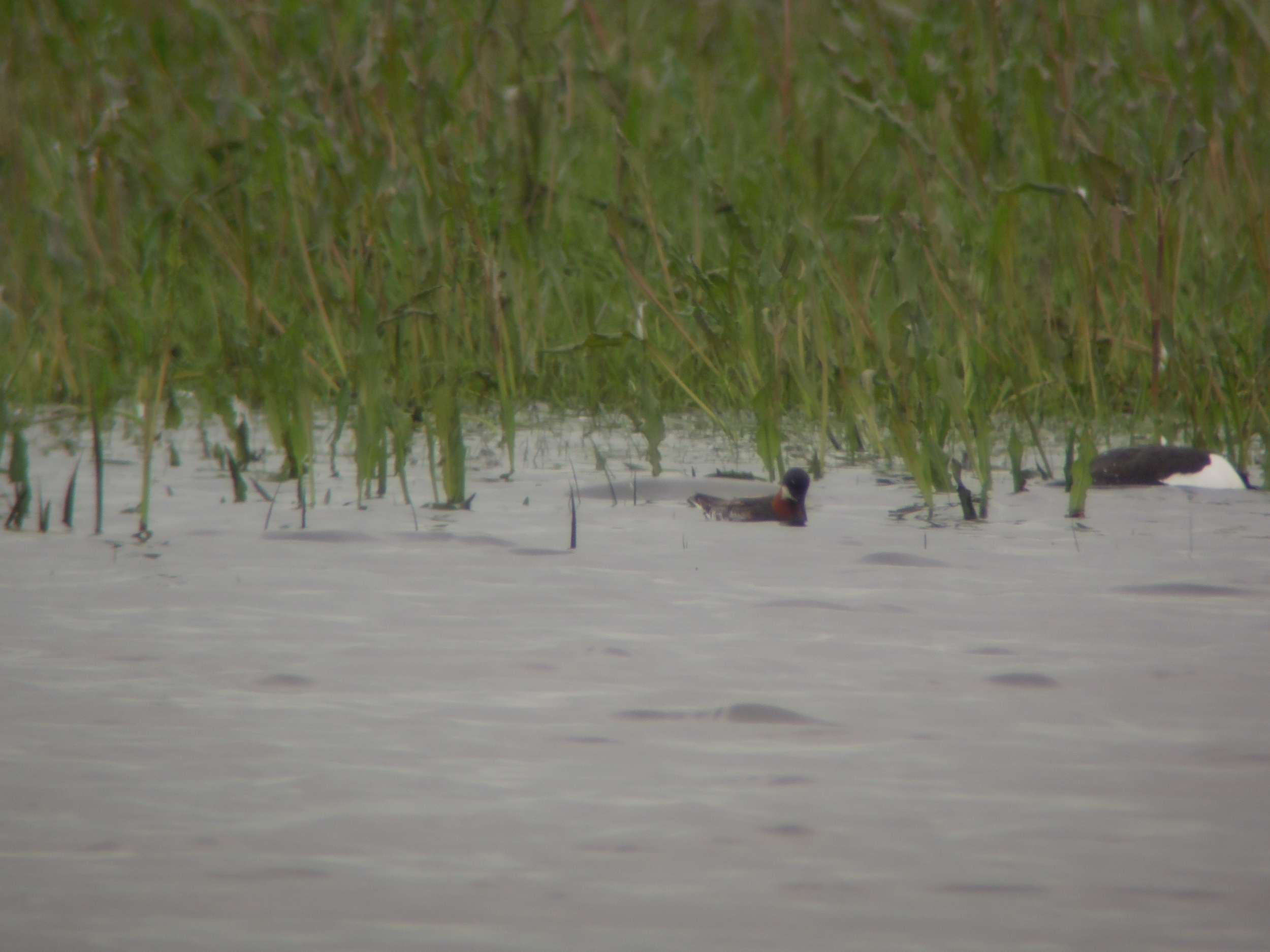
116 Red Phalarope Phalaropus fulicarius
Also known as Grey Phalarope, because when not in breeding plumage, that’s the colour they are. This bird was found at Farmoor Reservoir in 2007. As they often do, this bird was incredibly tame and swam about in circles close to the causeway.

